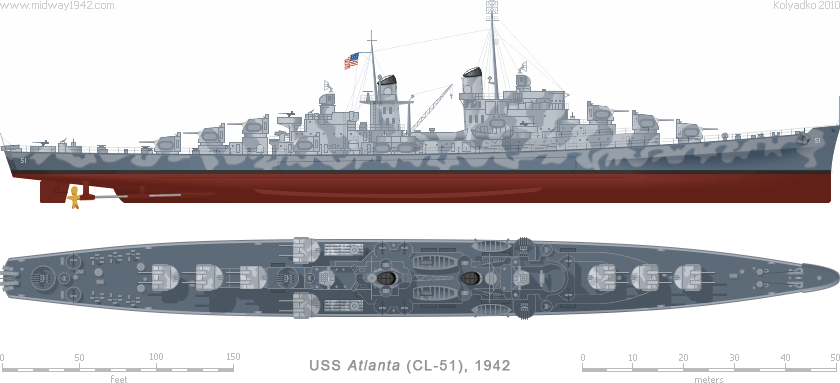
| Atlanta class | LIGHT CRUISERS | |

| Displacement: | 8,340 t (6,718 t Std) | Machinery: | 4 boilers, 2 shafts | DP Guns: | 8×2×5 in (127 mm)/38* | Main Belt: | 3.5-1.1 in | 89-28 mm | |||||||||
|---|---|---|---|---|---|---|---|---|---|---|---|---|---|---|---|---|---|
| Max Length: | 541 ft 0 in | 164.9 m | Max Power: | 75,000 hp | 55 162 kW | AA Guns: | 4×4×1.1 in (28 mm)** | Decks: | 1.25 in | 32 mm | |||||||
| Beam: | 52 ft 10 in | 16.1 m | Max Speed: | 33.6 kts | 62.23 km/h | AA Guns: | 8×1×.79 in (20 mm)** | Barbettes: | 1.5 in | 38 mm | |||||||
| Draght: | 20 ft 6 in | 6.25 m | Range: | 4,000 nm | 7 400 km | Torpedo Battery: | 2×4×21 in (553 mm) | Turrets: | 1.25 in | 32 mm | |||||||
| Complement: | 673 officers & enlisted | Bunkerage: | 1,528 t fuel oil | Depth Charges: | 2 roller racks, 6 throwers | CTower: | 2.5 in | 64 mm | |||||||||
* First four ships of the class, subsequent ships - 6×2×5 in (127 mm)/38, ** Antiaircraft armament as during the Battle of Midway (June 1942).
Atlanta class light cruisers were far more closely related to a very large destroyers than a light cruisers. They were designed as small, fast scout cruisers that could operate as destroyer flotilla leaders covering the destroyers against an enemy surface and air attack while the destroyers carry out a torpedo attack against enemy capital ships. But in common with many other cruisers, the Atlantas were sometimes used for different functions from those for which they were designed. As a result, two of them were sunk by Japanese cruisers and destroyers while formed up in a battle line of larger U.S. cruisers off Guadalcanal.
The ships had a main armament of relatively light guns, but in great numbers: sixteen of the 5 in (127 mm) dual-purpose guns in eight twin turrets, four of the new four-barrel 1.1 in (28 mm) autocannons were also fitted for close-in anti-aircraft defense. Unlike most U.S. cruisers of the period, they were equipped with torpedo tubes, depth charges, and sonars, reflecting their destroyer-like mission. Atlanta class light cruisers were most successful as anti-aircraft ships, so during World War II, their close-in anti-aircraft armament was drastically increased up to twenty-four (or even thirty-six) 1.57 in (40 mm) Bofors and sixteen .79 in (20 mm) Oerlikon autocannons at the cost of removing two wing 5 in (127 mm) turrets and all torpedo tubes.
One Atlanta class light cruiser (CL-51 Atlanta) took part in the Battle of Midway as a part of Task Force 16 Cruiser Group (Task Group 16.2).
| Ship | Builder | Laid Down | Launched | Commisioned | Fate | |||||||||||||
|---|---|---|---|---|---|---|---|---|---|---|---|---|---|---|---|---|---|---|
| CL-51 | Atlanta | Federal Shipbuilding. Kearny, NJ | 22 | Apr | 1940 | 6 | Sep | 1941 | 24 | Dec | 1941 | Sunk in action | 13 | Nov | 1942 | |||
| CL-52 | Juneau | Federal Shipbuilding. Kearny, NJ | 27 | May | 1940 | 25 | Oct | 1941 | 14 | Feb | 1942 | Sunk in action | 13 | Nov | 1942 | |||
| CL-53 | San Diego | Bethlehem Steel. Quincy, MA | 27 | Mar | 1940 | 26 | Jul | 1941 | 10 | Jan | 1942 | Sold for scrap | 3 | Feb | 1960 | |||
| CL-54 | San Juan | Bethlehem Steel. Quincy, MA | 15 | May | 1940 | 6 | Sep | 1941 | 28 | Feb | 1942 | Sold for scrap | 31 | Oct | 1961 | |||
| CL-95 | Oakland | Bethlehem Shipbuilding. CA | 14 | Jun | 1941 | 23 | Oct | 1942 | 17 | Jul | 1943 | Sold for scrap | 1 | Dec | 1959 | |||
| CL-96 | Reno | Bethlehem Shipbuilding. CA | 1 | Aug | 1941 | 23 | Dec | 1942 | 29 | Dec | 1943 | Sold for scrap | 22 | Mar | 1962 | |||
| CL-97 | Flint | Bethlehem Shipbuilding. CA | 23 | Oct | 1941 | 25 | Jun | 1944 | 31 | Aug | 1944 | Sold for scrap | 6 | Oct | 1966 | |||
| CL-98 | Tucson | Bethlehem Shipbuilding. CA | 23 | Dec | 1942 | 2 | Sep | 1944 | 3 | Feb | 1945 | Sold for scrap | 24 | Feb | 1971 | |||
| CL-119 | Juneau | Federal Shipbuilding. Kearny, NJ | 19 | Sep | 1944 | 15 | Jul | 1945 | 15 | Feb | 1946 | Sold for scrap | 29 | Apr | 1960 | |||
| CL-120 | Spokane | Federal Shipbuilding. Kearny, NJ | 15 | Nov | 1944 | 22 | Sep | 1945 | 17 | May | 1946 | Sold for scrap | 17 | May | 1973 | |||
| CL-121 | Fresno | Federal Shipbuilding. Kearny, NJ | 12 | Feb | 1945 | 5 | Mar | 1946 | 27 | Oct | 1946 | Sold for scrap | 17 | Jun | 1966 | |||